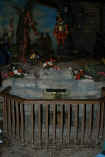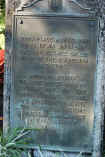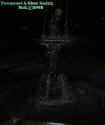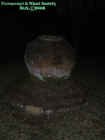|
|
||
|
Don Juan Ponce De Leon arrived in America in 1493 on a second voyage with Christopher Columbus. When he arrive here he went his own way and claimed the New World as Spain's. He was made a governor of Puerto Rico in 1510 and eventually made a voyage to the North or rather what is known as Central Florida today. Deleon often heard of Indians talk about Bimini an island of paradise to the north. Deleon set off on a voyage to find this mythical island. But since this land 500 years ago was strange to explorers the thought of a fountain of Youth excited DeLeon even more he did not find it and ended up staring accidentally his ship northwest hitting the Florida coast. Perhaps that is why he explored Florida so well maybe like we search for the paranormal his quest was based on finding a fountain of youth in the new world. DeLeon traveled the Gulf stream and Florida's east coast. The Fountain Of Youth National Archaeological Park is said to be the site where the Spanish Conquistadors first came ashore and claimed the continental United States for Spain. In 1513 in the Easter season of Pascua Florida meaning feast of flowers Ponce Deleon discovered land which is the presently St. Augustine. He named the land he discovered La Florida. The reason he named this was to commemorate the Easter season and the blossom-filled coastline he encountered. When they explored the area a priest came along with the soldiers and a mass of Thanksgiving was held near the Timucuan Indian village where they silently watched. After this time it took Spain six attempts to try and settle on the Florida coast but England was also at the same time trying to do the same. Spain would not succeed till 1565. The Fountain Of Youth site was the village of Seloy home to the Timucuan Indians for over 1500 years. The spring gave an endless supply of freshwater to the tribe. Fish and game were also abundant as at the time this was a very wooded area. They ate clams, oysters, fish, beans, pumpkins, squashes, corn, deer meat, turkey and other animals native to Florida. They drank tea called Cassina which had a high caffeine content made with the leaves of holly Ilex Vomitoria. The Seloy village was one of the other 30 villages in Central Florida. Their great chief was called Holata Ico. All the chiefs of the villages were drawn from a single clan of nobles named for the sacred rare white deer. When Ponce DeLeon and his men arrived in the St. Augustine bay he was welcomed by the Indians as a guest and they led him to the village where he stayed there for five days. Deleon found the natives to be strong, tall, and physically endured. Since they could not speak each others language they asked through sign language where they got their physical vigor. The Timucuan's pointed to the spring and that is how the fountain of Youth came to be. Ponce Deleon marked the Spring with a giant stone cross which sits in the ground. The cross has 18 stone slabs. Their are 15 in the staff and 13 in the beam symbolizing 1513 the year he discovered Florida. The cross almost 500 years old still remains and those who visit the Fountain Of Youth can also drink from it since till this day the water still comes out drinkable. At one time their was a Salt Cellar which was under the Spring house. A silver container was found here during a discovery here in the 1600s containing a scroll with writing in Spanish. When it was translated it was the words from Ponce DeLeon about the cross being placed here in the year of 1513. When the grounds were being excavated in 1934 some holes were being dug to plant some orange trees when human bones were discovered. The Smithsonian came to to evaluate the site and declared the area one of the most important finds in archaeology in the south. Their were over 100 skeletons discovered some pre historic while it was evident some were Christian burials. The remains were moved were reburied an given a Christian ceremony. Some of the first Christian Indians were buried here. Then if you were to walk on the grounds surrounding the Fountain of Youth here are archaeological markers, gardens, walkways, and even an Indian style BBQ is on display. Their are states of Chief Seloy and Ponce De Leon as well. Their is also a few civil war cannons and anchors which are part of a private collection. We did not find it yet but their is a monument marking the landing point of the Spanish that overlooks the water. Also on the grounds their is the Discover Globe which is a domed house where a presentation is given about the First Century of Spanish Conquest in the New World. Visitors can sit back in the theatre and enjoy a historical lesson. Then on site is a Planetarium where you will learn with a star pointer the ancient mysteries of celestial navigation and track Ponce Deleon's voyage to St. Augustine. Their is also Indian artifacts from the village and evidence of Pedro Menendez's colony in 1565 when St. Augustine was declared a city. Some say that King Ferdinand funded Ponce DeLeon with three vessels to find gold and there never was a mentioning of a fountain of youth. But if this was the case then why would Marco Polo in China have hard of such news across the other side of the world? Although some say these stories did not start taking place till many decades till after his death. Peter Martyr was a Spanish Historian was the first to mention the Fountain Of Youth with the connection to the New World. He never made mentioned a connection with De Leon. His mention stated that the fountain of youth was located near the Bay Of Honduras but later stated the Bahamas eventually changing it to Florida. Another story in 1535 was written by a Spanish Historian named Gonzalo Fernandez De Oviedo who wrote that the explorer was a desperate man who was seeking the Fountain of Youth as a cure for impotency. But records show that he had many young children however its possible this problem started previously or during his voyage. But what I believe is that DeLeon was a man who trained his whole life to be a warrior. He was a courageous explorer having journeyed with Columbus then removed from Puerto Rico from the king himself for conquering it and wanting to push on he was a brave tired knight. So of course it was only natural to want to prolong his life and carry on his journeys. At the same time Cortez was conquering Mexico slaughtering the Aztecs Deleon was mapping the entire coastline of Florida. He would journey through all the little inlets and bays one of them is Mosquito Bay where the Ponce DeLeon lighthouse sits near Daytona Beach. In 1521 Deleon set out for one of his last voyages as it was a stormy one with his two vessels in central Florida. This time he had a dream which was to form a settlement and brought with him colonist and domestic animals. He even had a priest with him to teach the Indians the Catholic beliefs. When they hit shore they were violently attacked and many were killed by the Calusa Indians. Deleon was a brave man he fought before retreating till a poison arrow hit him in the stomach. Then Spaniards retreated back onto the ships where they left for Cuba. Not to long after he died perhaps from the infection. Infections killed more soldiers then the wound because often the wounds were not treated properly. On his monument written in Latin is a quote that says "A lion by name and stilt more so by nature" is inscribed. The islanders of Hispanola and Puerto Rico were very saddened from the news since so many believed in this man. Honestly out of the many explorers of this time DeLeon was a true knight he did not slaughter the natives nor was he after power. He was just fascinated with adventure much like what we do here today exploring the woods and investigate the paranormal. Below you will find a little more information on DeLeon and his journey for the Fountain Of Youth. The Fountain Of Youth is one
hell of a mystical place but its also a place that to me is very haunted.
I mean this is the place of an Indian Village and Graveyard. These are not
amateur ghost but rather ghost that could be 1500 years old so some of
them are very advanced and it is very likely they knew our purpose but
welcomed us with open arms just as Ponce DeLeon was when he arrived here. By © Rick-AngelOfThyNight
|
||
|
|
||
|
|
|



















